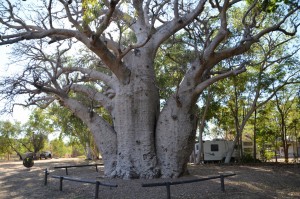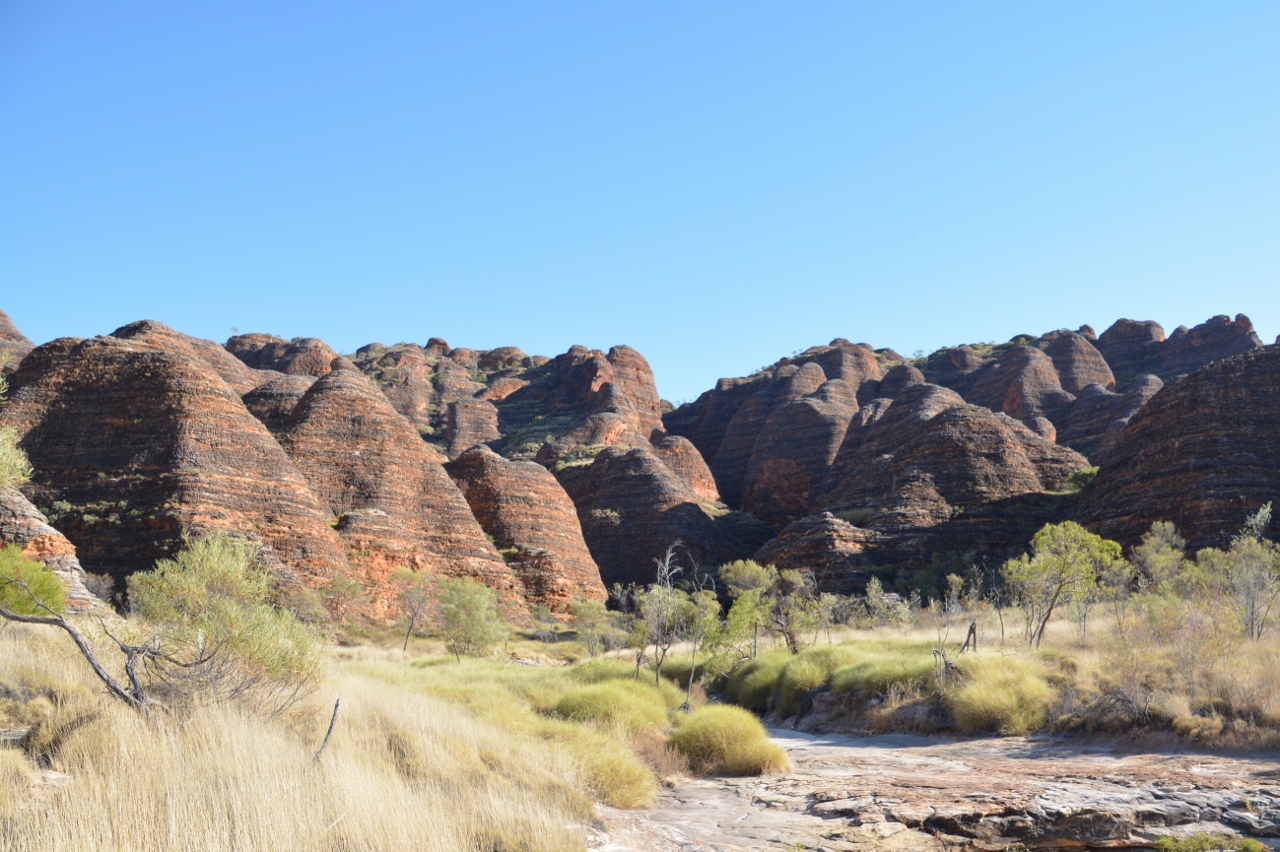Going West
Western Australia is overwhelmingly the largest state in Australia, roughly the same size as the US west of the Rockies, with a proud independent streak in their nature and unique culture. In the last ten years or more WA has been home to the huge resource boom, principally mining and offshore drilling, which has driven the Australian economy and saw it through the global financial crisis with barely a blip. In WA everything is big and most of it is wide open spaces.
The state’s northern region is referred to as the Kimberley, a vast almost unlimited space about twice the size of the United Kingdom and yet home to only about 30,000 people. With Kakadu it was one of two major targets of our journey and by crossing the border from the Northern Territory, and very inconveniently gaining one and a half hours, we were there.
It might sound trivial but when you are camping and living outdoors gaining 90 minutes by crossing a line in the road is a real pain. One day the sun sets at 7 pm and you get maximum time to enjoy slightly cooler temperatures and the nice fire. The next day it gets dark at 5.30pm and the sun rises at the ungodly hour of 5.30am – very unfriendly camping hours. This jet lag experience caused us to recalibrate our initial days in WA to get the most out of the day and get back in synch with the locals.
Right across the border in WA we came to one of the most dramatic engineering feats in Australia over the last 50 years. In the early 1970’s engineers dammed a gully of the Ord River which was only 350 metres wide and after only two wet seasons created a lake over 1,000 square kilometres in size that fundamentally changed life in the eastern Kimberley region. In one dramatic step Lake Argyle was formed and the region now had unlimited water year round for irrigation and farming, for pastoral activities, for the peoplein nearby townships, for recreational use and for tourism. In conjunction with the nearby Argyle diamond mines, which produces an astonishing third of all diamonds in the world including the unique pink diamond, this became a mini-boom area.
We booked a four hour sunset cruise to explore Lake Argyle and learn more about this amazing place. This was a small group on a small boat and we quickly saw the benefits again of booking with the smaller operator rather than the big boys. We crept around one corner of a rocky outcrop and our skipper threw food pellets to rare and shy small-eared rock wallabies that live in the crevasses of cliffs along the water’s edge. In another place we held pieces of bread over the water and small Archer fish came to the surface and shot water at it thinking it was shooting down an insect. A fish hunting out of the water! We saw many freshwater crocs, small groups of the common wallaroo called euros, and untold birds and other fish.
Twice we swam in the lake, initially to cool down from the 35 degree heat but at sunset we stopped for a swim and drink of either bubbly or beer as we floated on the water and watched the sun set over the nearby mountains. Our camp ground that night had an infinity pool where we swam and stunning views of the mountains next to us. We give Lake Argyle a thumbs up.
From there it was into the largest town in the East Kimberley region, Kununurra. Kununurra has a population of about 7,000 and like most communities in the region there is a large Aborigine contingent. We explored a few of the local sites, including Mirima National Park, restocked our supplies, made phone calls, checked our mails and did our research on upcoming activities. The next morning we pushed on.
One of the highlights of any journey to the Kimberley has to be the Bungle Bungles. All Australians have heard of them, seen them in photos, watched them on TV, perhaps even imagining that someday they will go there. The Bungle Bungle Ranges are actually a series of amazing rock formations that form the main feature of Purnululu National Park which since 2003 has been a UNESCO World Heritage location (the third one we have visited on this trip). But as amazing as this place is very few people visit it. In fact, they were only ‘discovered’ by white Australia in the early 1980’s and the extreme remote location, 50 km four wheel drive track into the camp and rough camping when you get there deters most people. Two wheel drivers and caravaners need not apply.
We spent two great nights in the Bungle Bungles and packed in just about everything a visitor can do, such is the limits to how you can see this amazing range and the size of the place. On the northern section we walked up to very deep and narrow chasms, at many points so narrow we could easily touch both sides of the 150 metre walls as we walked through. These were shot canyons that are filled with raging water during the wet season in unimaginable power and fury but are walkable in the dry season if you are prepared to scramble over huge boulders, squeeze through narrow openings and cram your neck upwards to marvel at the red sandstone walls above you.
The main feature of the Bungle Bungles are not the narrow canyons but the amazing domed sandstone rocks, frequently referred to as bee hives, that feature black and orange stripes and are often interlinked into an amazing series of formations. In fact, the Bungle Bungles have been here for about 20 million years through a freak of ocean, rock, water and changing geology but they are slowly eroding and it has been estimated they will disappear in another 20 million years. Get here quick I say before they’re gone.
We spent almost an entire day, starting at 7am and braving the torrid midday furnace, to explore the Piccaninny Creek which is the main feature of the Bungle Bungles. Walking up Piccaninny Creek is like walking into a magical world of strange shapes of the rocks around you and the rock you walk on. We detoured off the creek to do all the side tracks, including Cathedral Gorge and Whip Snake Gorge with their 100 metre high walls and huge amphitheatre at the end where water pours off the cliffs and flows out the narrow canyon.
But we continued the walk up the creek, it’s sold rock bottom scarred with long narrow grooves where water has manically flowed for thousands of years and carved deep gouges in the rock. And eventually, far from the Cruiser, and melting from the heat that hits you from above and then radiates off the white rock you are walking on, getting low on water and knowing our strength was ebbing, we turned around and walked back. Over the whole day and all the walks we did we covered about 22 kms, a long and extraordinary day on our journey around Australia.
But wait, there’s more. In keeping with the extreme end of sightseeing traditions in the Bungle Bungles, the next day we drove to the nearby helipad and jumped on a little four seater helicopter with no doors. Under the skills of our pilot Sam we spent 30 amazing minutes slowly weaving our way above these incredible rocks. Flying in a small helicopter without doors in a decent breeze requires substantial adrenalin and faith but with these in good supply we had one of the most enjoyable and thrilling experiences of our trip. The flights didn’t come cheap but they were great value.
Almost dizzy from what we saw on our amazing helicopter ride we drove on the rough track back to the highway and then up to the small town of Wyndham where we spent the night. Wyndham has a rich and colourful history as the key port for the early settlement of the region and we visited its museum, old stores and the amazing Five Rivers Lookout.

This Boab was in the middle of our Wyndham campsite - said to be 'the oldest Boab in Captivity' at 2,000 years
High above the town after following a steep winding road we hit this lookout 200 metres above the Cambridge Gulf. From this lookout you can see the five rivers – the Ord, Pentecost, Durack, King and Behn – that flow into the gulf and drain this region of all its water. It was from this point that many early explorers landed their boats and began their journey. Even today iron ore and nickel are brought from the nearby mines by 55 metre long road trains – trucks pulling up to four huge carriages – and loaded onto massive container ships for shipment overseas. Quite a place for such a little town.


















